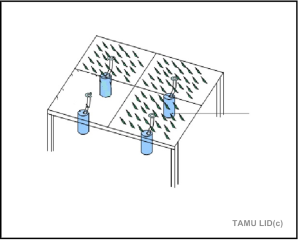The five LID BMPs targeted in this study are permeable pavements, bioretention area, rainwater harvesting, green roofs, and detention ponds. These Best Management Practices (BMPs) are being used to provide examples of how LID can be integrated in new buildings and developments or retrofitted to existing developments that aim at reducing sediments (and sediment bound pesticides), and nutrients loadings into urban runoff.
Green roofs are vegetated roof tops that offer an alternative to conventional impervious roofing systems. Also known as ‘living roofs’, they retain and reduce stormwater runoff, as well as delay the time of peak runoff so that there is a reduced chance of flooding.
Typical green roof construction has layers that include a roofing membrane and root barrier that provides protection to the roof structure and stops plant roots from affecting it, a drainage layer that retains water as well as channel excess water away from the roof to a downspout, a geotextile or filter layer that prevents fine particles from being washed away, a growing medium that can be of varying thickness and coarseness according to manufacturers, a vegetation layer that comprises of plants that can withstand extreme conditions such as heat, drought and wind. Green roofs are known to intercept between 15 and 90% of rooftop runoff. However, type of growth medium, thickness and plant cover variability can cause differences in runoff of 50-60%. The green roofs in the current project aim to study differences in runoff in roofs with thicker growth media, and a native plant palette as compared to a conventional commercial green roof design.
Each roof (Figure 11 and above image) consisted of four different treatments: a conventional green roof, as made by Hydrotech, Inc.; a green roof design that consists of the plant layer, soil mix, drainage layer, and roofing material; a green roof design consisting of plant layer, soil mix and roofing material; a control roof with no vegetation. Plants were selected to withstand minimal maintenance.
The volume of runoff collected from the green roof experiment is shown below. The data shows that the average reduction rates were 68%, 79%, and 78% for the Hydrotech (H), Soil(S), and Soil with drainage (SD), respectively. The lower reduction in the H treatment is probably due to the smaller soil depth used in that treatment.
The table below shows the average pollutant load per storm during the collection period and the reductions in pollutants in all treatment as compared to the no green roof control. Nitrate- nitrogen was nearly unchanged with some reduction in H and SD and minor contribution in S. Orthophosphate was reduced in S and SD but H contributed orthophosphate. Total suspended solids were reduced in all three treatments. E. coli was reduced in S and contributed in H and SD. The reduction of volume in the green roof had a considerable impact on reducing pollution from green roofs as the comparison of reduction in loads to the reduction in concentrations shows. It is likely if green roof drainage is released on a grassed area, the pollutant concentrations could be reduced to be similar rates as ambient flows for Nitrate, phosphate and E. coli with considerable reductions in TSS.
| Pollutant | H % reduction | S% reduction | SD% reduction |
| NO3 | 14 | -11 | 2 |
| Orthophosphate | -69 | 49 | 26 |
| TSS | 39 | 75 | 63 |
| E. coli | -107 | 89 | -135 |

